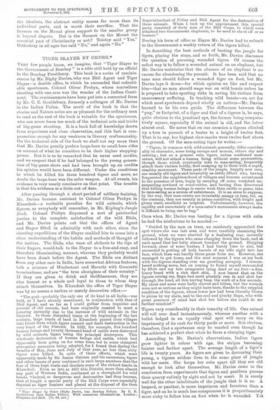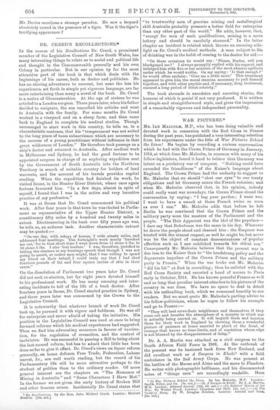TIGER SLAYER BY ORDER.* VERY few people know, we imagine,
that " Tiger Slayer to the Government of Bombay" is a title still held by an official in the Bombay Presidency. This book is a series of reminis- cences by Mr. Digby Davies, who was Bhil .Agent and Tiger Slayer—a double office, in which he succeeded that redoubt- able sportsman, Colonel Oliver Probyn, whose marvellous shooting with one arm was the wonder of the Indian Conti- nent. The reminiscences have been put into a connected form by Mr. C. E. Gouldsbury, formerly a colleague of Mr. Davies in the Indian Police. The merit of the book is that the stories and Nature notes are as pleasant for the ordinary man to read as the rest of the book is valuable for the sportsman, who can never learn too much of the technical arts and tricks pf big-game shooting. It is a book full of knowledge drawn from experience and close observation, and this fact is com- pensation enough for any weakness in literary craftsmanship. On the technical side of the book we shall not say more than that Mr. Davies greatly prefers large-bore to small-bore rifles on account of what he considers to be their higher stopping- power. But it is to be remarked that he never used cordite, and we suspect that if he had belonged to the young genera- tion of big-game shots and had been brought up .on cordite his opinion would have been different. • Under the conditions in which ho killed his three hundred tigers and more, no doubt the large.bore was the safer weapon. At all events, his evidence is very nearly conclusive on that point The trouble is that his evidence is a little out of date.
After passing through a short period of military training, Mr. Davies became assistant to Colonel Oliver Probyn in Khandesh--a veritable paradise for wild animals, which figures, as everybody will remember, in Mr. Kipling's Jungle Book. Colonel Probyn dispensed a sort of patriarchal justice to the complete satisfaction of the wild Bhils, and Mr. Davies points out that the offices of Agent and Slayer fitted in admirably with each other, since the shooting expeditions of the Slayer enabled him to come into a close understanding of the habits and methods of thought of the natives, The Bhils, who were all shikaris to the tips of their fingers, would•talk to the Slayer in a free-and-easy, and therefore illuminating, manner, whereas they probably would have been dumb before the Agent. The Bhils are distinct -trona any other race in India, have somewhat African features, talk a mixture of Hindustani and Marathi with Guzeratti terminations, and are "the true aborigines of their country."
If they are given to drink and thriftlessness, they are also honest as a whole and loyal to those to whom they attach. themselves. In Khandesh the office of Tiger Slayer was by no means a useless or merely decorative office "The post—probably the only one of its kind in all India—was held, as I have already mentioned, in conjunction with that of 13h11 Agent, and as far as I could gather from inquiries and perusal of • old records, had been originally created to meet a pressing necessity due to the increase of wild animals in the District. In those disturbed times at the beginning of the last century, large tracts of land in Khandesh passed from villages into forest from which tigers roamed and dealt destruction in the very heart of the District. In 1822, for example, five hundred human beings and twenty thousand head of cattle were destroyed by wild animals, tigers being the principal destroyers. This wholesale destruction of human beings and cattle, which had apparently been going on for some time, led to some stringent preventive measures being adopted, for I found that during the months of May, June and July of that year, no less than sixty tigers were killed. In spite of these efforts, which were apparently made by Sir James Ontram and his successors, tigers and other beasts of prey continued in such large numbers that the fear of them kept waste and desolate some of the richest tracts in Khandesh. Even as late as 1867 this District, more than almost any part of Western India, continued as a stronghold for wild beasts. Indeed, so dangerous and destructive had they become, that at length a special party of the Bhil Corps were especially deputed as tiger hunters and placed at the disposal of the then • Tiger Slayer by Circler (Dtgby Davies, late Bombay Polio.), By 0. E. Gouldebury (late Indian Police). With numerous Illustratiwo, London : Chapman and Hall. [7s, 13d. net.
Superintendent of Pollee and Bbil Agent for the destruction of these animals, When I took up the appointment this special party consisted of forty men of the Bhil Corps, to which were attached two Government elephants, to be used to shoot off or as beaters."
During his term of office as Slayer Mr. Davies bad to submit to the Government a weekly return of the tigers killed.
In describing the best methods of beating the jungle for tigers, placing the stops, and so forth, Mr. Davies discusses the question of pursuing wounded tigers. Of course the safest way is to follow a wounded animal on an elephant, but Mr. Davies maintains that the absence of an elephant is no excuse for abandoning the pursuit. It has been said that no sane man should follow a wounded tiger on foot, but Mr. Davies lays it down—for which opinion we like and respect him—that no man should wage war on wild beasts unless lie is prepared to take sporting risks in saving his victims front unnecessary suffering. In tracking wild beasts—an art for which most sportsmen depend wholly on natives—Mr. Davies learned to be his own guide. The difference between the "pug," or footprint, of a tiger and that of a tigress is, he says, quite obvious to the practised eye, the former being compara- tively square, especially if the animal is old, and the latter almost oval. He notes that on one occasion a tigress climbed up a tree in pursuit of a beater to a height of twelve feet. That is to say, her highest claw-marks were twelve feet above the ground. Of the man-eating tiger he writes :— " Tigers, in common with wild animals generally, differ consider- ably in character, some being savage and morose, others shy and retiring ; but as a general rule, tigers, unless confirmed man- eaters, will not attack a human being without some provocation, though those which eventually take to man-eating, frequently attack their victims boldly, first creeping up to them with a rapid, stealthy movement. These pests of the jungle, happily now rare, are usually old tigers and invariably ex-cattle lifters who, having frequented the neighbourhood of villages and become accustomed to the presence of men, begin by carrying off some wretched un- suspecting cowherd or wood-cutter, and, having thus discovered that killing human beings is easier work than cattle or game, take to man-eating as a source of subsistence. It is an error to suppose, by the way, that man-eaters are invariably mangy or lean, for, on the contrary, they are usually in prime condition, with bright and glossy coats, excellent as trophies. Unfortunately, however, the rapidity and uncertainty of a man-eater's movements always make it difficult to bring one to bag."
Once when Mr. Davies was beating for a tigress with cube he had the misfortune to be mauled :— " Guided by the men on trees, we cautiously approached the spot where she was last seen and wore carefully examining the ground, when we were startled by a deafening roar, instantly followed by the tigress who came charging down the bank, and at such speed that her belly almost touched the ground, Stopping forward, clear of some bushes, I had barely time to aim. but succeeded in getting off both barrels of my rifle right into her face, which then was hardly three paces from me. However, she managed to get home, and the next moment I was on my back with the tigress standing over use growling savagely. I remem- bered nothing more, but on coming to found myself surrounded by Bhils and my late antagonist lying dead at my feet—a fine, heavy beast with a rich dark skin. I now learnt that on the tigress seizing me, Bapu had most pluckily run in and shot her through the head, all this having been the work of a few seconds. My chest and arms were badly clawed and bitten, but the wounds were not so serious as they might have been, thanks to the crippled condition of the tigress, whose lower jaw had been literally blown to pieces by my shots, and to the cool and plucky Bapu, who with great presence of mind had shot her before she could do me further mischief."
Tigers vary considerably in their tenacity of life. One animal will roll over dead instantaneously, whereas another with a bullet lodged in an equally vital spot will carry on the impetuosity of its rush for thirty yards or more. It is obvious, therefore, that a sportsman may be mauled even though he has achieved a perfect shot when be faces a charging tiger.
According to Mr. Davies's observations, Indian tigers grow lighter in colour with age, the stripes becoming fainter and farther apart. The average length of a tiger's life is twenty years. As tigers are given to devouring their young, a tigress seldom lives in the same piece of jungle with her mate. She keeps her cubs apart till they are old enough to look after themselves. Mr. Davies came to the conclusion from experiments that tigers and panthers pursue their quarry entirely by sight and not by scent. It is surely well for the other inhabitants of the jungle that it is so. A leopard, or panther, is more impetuous and ferocious than a tiger, and as he is much less conspicuous it is proportionately more risky to follow him on foot when he is wounded. Yet Mr. Davies mentions a strange paradox. He saw a leopard absolutely cowed in the presence of a tiger. Was it the tiger's terrifying appearance P

















































 Previous page
Previous page